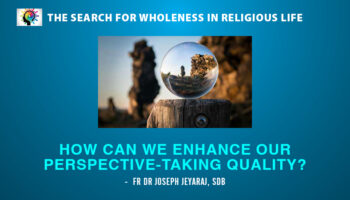In last month’s article, the author explained the meaning of stress, its symptoms and links to health and sickness, and the so-called “fight or flight” syndrome. This second instalment looks at four factors that can induce stress. Check and see what seems to contribute to stress in your life.
When my friend Thomas told me he was stressed out and asked for help, I had told him it was no wonder he was stressed out since he was a perfectionist. But that was not all that I had said in response. Over a cup of coffee, I gave him a lesson on stress! Among the things I highlighted were the four major sources of stress.
- INAUTHENTICITY
The biggest source of stress in our lives is perhaps inauthenticity. The discrepancy between who we profess to be in public and who we actually are away from the public gaze can be source of chronic stress. For example, Jerry presents in public the façade of a happy family man and a faithful husband, and often talks about the importance of integrity in professional, family and marital life. But secretly he is involved in an extramarital affair. The effort to hide the truth from his wife and colleagues and the fear and anxiety that his affair might become known will keep him on a high level of stress.
Inauthenticity can manifest in different ways. For example, Rose is entrusted with the management of finances in her institution but is secretly siphoning away monies. Andrew, who holds a leadership role, is involved in an illicit land deal. Both will be in a state of high alert, trying to hide their unethical behaviours. This state of high alert will result in chronic state of stress, unless they have become totally immune to the pricks of conscience and believe there is nothing unethical about their behaviours.
- TYPE-A PERSONALITY
Stress often accompanies what has come to be known as Type A Behaviour Pattern (TABP) or Type A Personality (TAP).
According to psychologist Ray Rosenman, Type A Behaviour is an action-emotion complex that includes both behavioural and emotional dispositions. Behavioural dispositions include aggressiveness, competitiveness, and impatience and accelerated pace of activities. Emotional processes include irritation, covert hostility, and easily aroused anger.
Type A personalities are go-getters. They lead a life of frenetic activity and are driven by a compulsive need to achieve, and averse to taking time to relax. They are restless and remain on a high adrenaline rush. They like to be in total control of the environment. Any perceived threat to control or success evokes in them anxiety-provoking thoughts which in turn trigger physical and emotional reactions typical of the stress reaction.
Type A personalities are easily angered by others, readily blame others, take offence quickly and manifest cynical hostility—all of which are sources of stress.
The Type A behavioural and emotional pattern is closely linked to both physical and psychological disorders. From a physical perspective, Type A personalities are more vulnerable both to coronary heart disease (CHD) and coronary artery disease (CAD). From a psychological perspective, they tend to trigger interpersonal conflicts and become irritant to those around them.
- WORK AND ITS ENVIRONMENT
The nature of work and the quality of the work environment have significant bearing on levels of stress experienced. When workers experience powerlessness in regard to decision-making, little social support from managers or fellow workers, imbalances between effort or reward, job insecurity, role ambiguity in terms of what is expected of them, or an unpleasant work environment, they are likely to experience high levels of stress which also tend to be chronic.
A Norwegian study presented at an International Conference on Work Environment and Cardiovascular Disease a few years ago, showed that even just the rumour of a factory’s closure caused enough stress, so much so that workers’ pulse and blood pressure spiked, making them vulnerable to cardiovascular diseases. Findings from the Stockholm Heart Epidemiology Programme Study found that participants who reported having pressure or facing competition at work faced a risk of myocardial infarction six times greater than normal during the following twenty-four hours.
Workaholism and stress are related. Workaholics generally tend to be too intense and their intensity can make them remain at high levels of neuro-muscular arousal for long hours and thus impair the body’s normal functioning.
According to Dr. Marilyn Machlowitz, one of the leading authorities on workaholism,
workaholics tend to be intense and energetic, tend to sleep less than most people, have difficulty taking vacations or time off, spend most of their waking time working, frequently eat while they work, and worry about making the most of their time. They schedule appointments too tightly, and are generally impatient with most people. They tend to be perfectionists–seeking flawless performance from self and others.
No wonder they have been shown to have a much higher rate of heart attack than “Type B” personalities—those who are not excessively competitive and are relatively easy-going.
Workaholism is often a way of dealing with the anxiety that arises from our feelings of inadequacy, especially in personal relationships. When we find relating to people difficult, we compensate by emphasising accomplishment. Work becomes an easy defence against the vulnerabilities involved in close relationships. We seek to meet our need for love and affirmation through accomplishment.
Workaholism is sometimes a defence also against listening to our inner voices. Overwork serves as a narcotic that numbs our inner turmoil, an escape from the uncomfortable feelings inside. If we are always busy doing something, there is little chance for these feelings to come to the surface and demand to be heard. We drown out our inner voices though overwork.
- INTER-PERSONAL CONFLICT
Today psychological theory and research attest to the important role relationships play in promoting health and happiness. In an earlier column I had referred to the Harvard Grant Study, which found loving relationships to be the most significant variable that affects health and happiness. Unresolved interpersonal conflict undermines loving relationships and is a major stress inducer.
Conflicts evoke anger, blame, overt and covert hostility – all of which are stress inducers. Inter-personal conflicts keep the body in a state of neuromuscular hyperarousal – the same physiological state that results from stress. This in turn leads to physical and psychological impairment.
One major dynamic that maintains inter-personal conflict is unwillingness to forgive. Forgiveness is a decision to let go of a hurt or offence someone has caused us, so that we are no longer psychologically held or dominated by what has happened and are able to move on. Lack of forgiveness keeps us brooding resentfully over perceived or real hurts or offences. We pay a price for such resentful brooding.
Dr. Herbert Benson, Director of the Mind/Body Medical Institute at Harvard University and the author of the ground-breaking Relaxation Response, made a profound observation about the health hazards of unforgiveness: “There’s a physiology of forgiveness. When you do not forgive, it will chew you up!”
On the other hand, forgiveness serves as a major resource for dealing with life’s inevitable hurts, frustrations and offences and leads to a calmer and more peaceful way of living.
The sources of stress described in this article themselves point to what we can do to prevent and recover from stress. However, in the next issue I shall describe some specific helpful strategies.
For Reflection
What are your experiences around the sources of stress described in this article? What insights do they provide you for dealing with stress?
Fr Jose Parappully SDB
To subscribe to the magazine, click Subscribe





